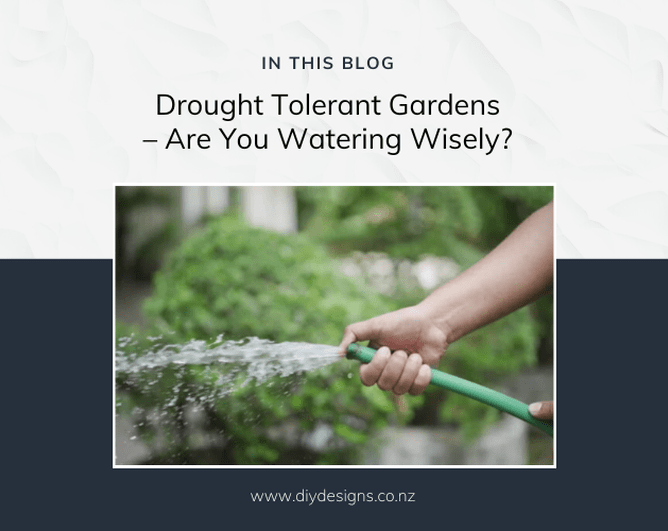Wise Watering or Drought Tolerant Garden?
Drought-tolerant gardens have been a popular choice for many years and, if your isn't, summer is a good time to think about how you can reduce your water usage in garden.
Heading for the succulent section of your local garden centre and planting Xerophytic desert plants might seem like the answer to a hot dry summer, but these don’t suit all climates or garden aesthetics, and with the other extremes of wet weather experienced in recent months, a lot of gardeners have found that having a garden full of drought-tolerant plants creates a whole other set of problems when the heavens open...and stay open!
So what's the answer? Well, first of all, it's always wise to plant what works locally, these plants will have an inherently better chance of survival. Planting what we like the look of comes a close second, because, let's face it, we want to enjoy looking at our gardens.
But no garden is going to look nice if the plants have wilting foliage and droopy flower heads. And, as pleasurable as it may be, watering the garden can cause the water-conscious gardener some angst.
We need to plant plants that can cope with some water in the wetter seasons and get smart about how we water our gardens during the endless dry days of summer when you will undoubtedly find the less drought-tolerant plants in your garden looking a little thirsty.
Before the toughest days of the long, hot summer period hit is a good time to assess HOW you are watering and to consider how you can reduce water consumption in the garden by watering wisely, as and when your plants need it.
‘6 TOP TIPS ON WATERING WISELY’
Here’s our top 6 garden designer tips on how to save water in the garden by watering wisely.
Water Wise Garden Tip 1 : Break The Habit
Watering the garden can become a routine task, something you do at a certain time of day even if it doesn't really need doing. So, before you drag out the hose or start the watering system, check if your garden really is dry before you start watering. Because the top 5-10cm of garden dries out the fastest, your soil may look drier on the surface than it actually is deeper down, when the plant's roots are.
If you think you might be watering out of habit, scratch back the surface of the soil before you turn the tap on. You may find the moisture levels below are fine and you don’t need to water at all, or you can reduce your water consumption by spot-watering just those plants that are showing signs of stress.
Water Wise Garden Tip 2 : Slow The Flow
When you are watering your garden, thirsty soil can be slow to absorb water. Therefore excessive, heavy watering can result in wasteful run-off. You can use less water in the garden if you give parched soil (and plants) a chance to absorb moisture with a ‘water then wait’ approach. This method works very well if you are hose watering.
With a slow flow pressure, water one plant for around 5 seconds, then wait a few minutes (while watering other plants) then return to the original area and water some more. Repeat across the garden. This slow flow of water enables the soil to absorb the water between applications.
Another good watering trick is to make an indented donut-like ring in the soil around your plant root zone, around 5-7cm deep. This captures and holds water that can then slowly be absorbed into the soil.
Use these two water-wise ways to efficiently give the ground around your plants a nice, deep soaking, which is what your plants really need. Which brings us to point 3 - going deep!
Water Wise Garden Tip 3 : Go Deep
While it’s fun to wave the hose around, constant, shallow watering makes for insufficient water penetration, and as dry soil is harder for plants to grow their roots downwards into, they tend to become shallow-rooted. When roots sit near the surface they will dry out faster, meaning they are less likely to cope with dry spells or arid growing conditions than deeply rooted plants.
You can help train your plants to become more drought tolerant by encouraging their feeder roots to grow deep down, where the soil moisture levels are generally higher, by watering less frequently for longer - around 30 minutes, to deep-soak the soil.
Deep soaking is especially important when new plants are establishing, as once established, even in dry spells you can get away with more infrequent watering if your plants are deeply rooted.
Water Wise Garden Tip 4 : Take Control
When you 'blanket water' the garden, such as with a sprinkler, not only are you wasting water, you’re also likely to encourage weed growth between plants. Irrigation systems are a great way of taking control of your garden water consumption. Clever irrigation systems mean you can direct moisture exactly where you need it, and both drip irrigation and soaker hoses are ideal for reducing water run off by promoting efficient deep watering. These also have advantage over sprinkler or spray systems of being able to be fitted around your plants only, wisely delivering water right where it needs to go. Hose watering, while time consuming, also gives you this same directional control over where you water. Another bonus of soaking versus spraying, is that less water is directed onto foliage, helping prevent leaf fungal diseases such as rust, black spot, powdery mildew that may be promoted, particularly on older plants, if foliage remains wet overnight.
Water Wise Garden Tip 5 : Timing is Key
Timing your water use is essential to reducing water use in the garden. Plants use more water in windy conditions and on hot, sunny days, plus evaporation losses from the soil surface are also higher, so it’s natural to think you should water more on these days. However, these same conditions mean you also will lose a lot of your water to evaporation while irrigating or hose watering, so the best time to water wisely is on still days in the early morning or late afternoon. Just don’t leave your watering too late in the day, as in addition to those leaf fungal diseases you may be encouraging, moist surface soils overnight can also promote fungal disease, particularly in small plants or young seedlings.
Water Wise Garden Tip 6 : Mulch, Mulch, Mulch.
One of the best things you can do to improve soil and plant health is to mulch, mulch, mulch and mulching also has great benefits when it comes to watering wisely in the garden.
A 5-15cm layer of mulch over your garden beds will improve summer moisture retention by helping reduce water evaporation from sunlight and drying winds, because the surface soils are better insulated against the baking effects of the summer sun. Below ground, soil temperatures also remain lower and more consistent, putting less stress on plant roots. Mulched soils also absorb water faster. The thickness of the mulch layer will depend on the type of mulch you use.
Coarse, fibrous mulches such as bark and arborist’s mulch offer good water flow and can be are applied thickly, around 10-15cm. These are great for around trees and larger shrubs. Smaller shrubs and herbaceous plants are better suited to finer mulches, such as compost mulch or bark fines These should be laid more thinly, around 5-7cm, as they have a much smaller particle size and when laid too densely the layers of fine material may block actually block water from penetrating the soil and getting to the roots of your plants.
The best time to mulch in a water wise way is after heavy or consistent rain, when the soils are naturally moist.

